How to start an online clothing store in India? Well, there are multiple ways to go about launching your own apparel brand online. The popular term for it in the industry is “D2C Brand“. Where your store and brand exist only on the Internet (online), have no physical stores, and sell directly from its own website and from other marketplaces.
Starting an online clothing business is a great idea. With the distribution channels like Instagram, YouTube, Social Media Ads, and Amazon/Flipkart/Myntra-like marketplaces, a lot of things get sorted for a new clothing brand in India.
Western wear is the most favoured apparel category with men buyers driving more than 60% of the purchases. Footwear and Accessories are expected to grow in online channels at a CAGR of 33% which is largely attributed to consumer aspirations and a larger variety of choices.
In this blog, we’ll explore how you can also start your own online clothing brand, set up for clothing brand’s online store, and start selling products pan India. There are multiple ways to do it and we are going to explore all of them here. So let’s dive in ????
Table of Contents
Online Clothing Business vs. Offline Clothing Stores
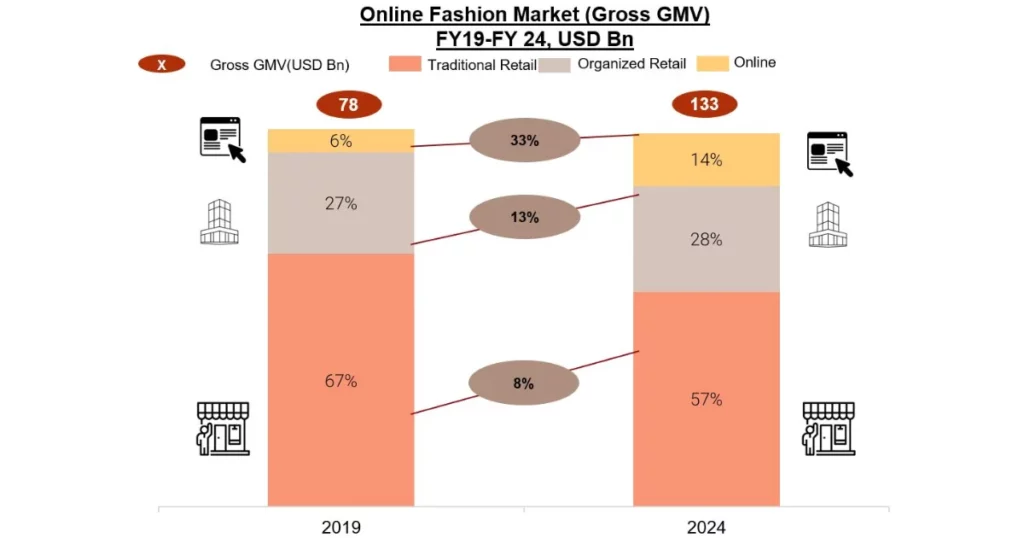
Online Clothing Business
- Wider Reach: Online stores can attract customers from all over the world, not just from one location.
- Lower Overheads: No need to pay for physical retail space or utility bills.
- Convenience: Customers can shop at any time, and businesses can operate 24/7.
- Personalization: Use data analytics to offer personalized shopping experiences and recommendations.
- Easier Inventory Management: Automate inventory tracking and reduce the risk of overstocking or stockouts.
Offline Clothing Stores:
- Tangible Experience: Customers can see, touch, and try on clothes before purchasing.
- Immediate Gratification: Purchases made by customers can be taken home right away.
- Customer Interaction: Personal interaction can build strong customer relationships and loyalty.
- Brand Presence: A physical store can enhance brand visibility and trust in the local community.
- Impulse Buying: Attractive displays and in-store promotions can lead to impulse purchases.
How to start an online clothing store in India
There are multiple ways to start a clothing brand in India (or a clothing store in India). In this blog, we’ll discuss them both with more focus on an owned store in comparison to a brand. The difference is that a clothing brand’s store will be an online portal owned by you to sell your products to consumers online. On the other hand, an online apparel brand will rely on marketplaces like Amazon, Myntra, Meesho, Flipkart, etc. for its distribution.
Though, mostly all the players in the D2C apparel space establish both online points of purchase for the buyers: owned e-commerce website and its presence in multiple places.
Please note that in this article we are not going to cover how to get your GST number to do online business, how to file GST returns, SEO for e-commerce stores, and how to run ads to bring sales. The purpose of this blog is to get your clothing brand up and running in India.
Let’s see the step-by-step guide to starting an online clothing store in India:
1. Decide on a Clothing Niche

- Identify Your Target Audience: Determine the demographic you want to cater to, such as kids, teens, adults, or seniors.
- Specialize: Choose a specific niche within clothing, like ethnic wear, activewear, formal wear, or sustainable fashion.
- Trendy vs. Timeless: Decide if you want to focus on trendy, fast-fashion items or timeless, classic pieces.
2. Develop an Online Business Strategy
Choose between different models like dropshipping, print-on-demand, or maintaining your own inventory. Calculate your initial investment and ongoing costs, including website development, marketing, and inventory. Create a unique brand name, logo, and tagline that reflect your brand values and appeal to your target audience.
→Conduct Market Analysis
- Understand the Market: Research the current market trends, customer preferences, and demand for your chosen niche.
- Customer Insights: Use surveys, social media, and forums to gather information about what potential customers are looking for.
- SWOT Analysis: Identify your strengths, weaknesses, opportunities, and threats to understand where your business can thrive and where it might face challenges.
→Analyze Your Competitors
- Identify Competitors: Look for other online stores that sell similar products.
- Evaluate Competitors: Analyze their strengths and weaknesses, product range, pricing, and customer service.
- Benchmarking: Use competitors’ successful strategies as benchmarks and identify gaps in the market that your store can fill.
3. Setup your supply chain
There are 3 ways to setup the supply chain of your clothing store. By supply chain, we mean the sourcing/procuring, packaging, customising, and storage (warehousing) of these products.
→Print on Demand (POD)
No. 1 on the list is Print-on-demand. As the name suggests, a print-on-demand brand prints apparel on demand (on receiving orders). You can partner with any print-on-demand service provider in India and connect your store with them. Here are 25 best print-on-demand sites in India. You can browse through the product catalogue, choose the products you want to sell, customise them with your own designs, and start selling. Now, as and when you get the orders, your print-on-demand partner will print on getting the order and ship it to the buyer through 3rd party shipping partner.
Blinkstore has an inbuilt integration with Print-on-Demand, payment gateway, and shipping. So if you choose Blinkstore to start your online clothing brand in India, you won’t need anything else.
→Dropshipping
Dropshipping involves partnering with suppliers who manage inventory and ship products directly to your customers. This model requires minimal upfront investment and eliminates the need for inventory management. You can use Blinkstore for your dropshipping business as it is free and user-friendly.
- Advantages:
- Minimal Investment: No need to purchase inventory upfront.
- Wide Product Range: Ability to offer a broad range of products without worrying about storage.
- Scalability: Easy to scale your business by adding new products and suppliers.
→Private Label
Private labeling involves creating your own brand. By having products manufactured to your specifications. This model requires more upfront investment and planning but can lead to higher profit margins and stronger brand identity.
- Advantages:
- Brand Control: Full control over product quality, branding, and packaging.
- Higher Profit Margins: Potentially higher margins compared to POD and dropshipping.
- Customer Loyalty: Building a strong brand can lead to higher customer loyalty and repeat business.
→Custom designing and stitching
If you are a designer and/or you’ve original ideas on the design and stitching of the clothes. Then you’d need to partner with a tailor or a mass manufacturer of garments and apparel who can product apparel as per your requirements. Working with a few tailors is only suitable for boutique clothing brands and couture fashion brands. For doing it at a scale, you’d need to partner with a 3rd party manufacturer.
In this method, you’d need to spend upfront to procure inventory before starting your promotions and sales.
→Sourcing apparel from 3rd party
The last method is to partner with a 3rd party manufacturer of apparel. Where you can only choose what products you want to list on your store from the large pre-manufactured catalogue. You’d find such apparel manufacturers who deal in bulk selling of apparel mostly in Tirupur, Noida, Surat, Kolkata, etc. The hubs of apparel manufacturing and markets are good places for finding a partner for apparel.
This would require you to spend upfront on procuring products and/or for storing them in a warehouse. Then you can ship them to your online buyers.
4. Select ecommerce platform and create online store
To create your online store, you can either use no-code tools or e-commerce store builder platforms. Or go to the custom-developed root. If you want to build it yourself, you’d need to hire a couple of developers to code and develop your own e-commerce store. It’ll require a different kind of time and money in investments.
But the most popular choice is to go with a store builder like Shopify, Woocommerce, Wix, Adobe Commerce (Magento), Blinkstore, etc. Setting up your store with the help of a no-code store builder is easy, fast, and they are reliable. It takes less than a few minutes to get started with most of these platforms like Shopify, Wix, and Blinkstore.
Once your store is created, you can learn the advance features on these platforms to customise your storefront and add functionalities to it as per your brand requirements.
Now that your online store is ready, you can move on to the next step of setting up your supply chain.
5. Choose an effective domain name
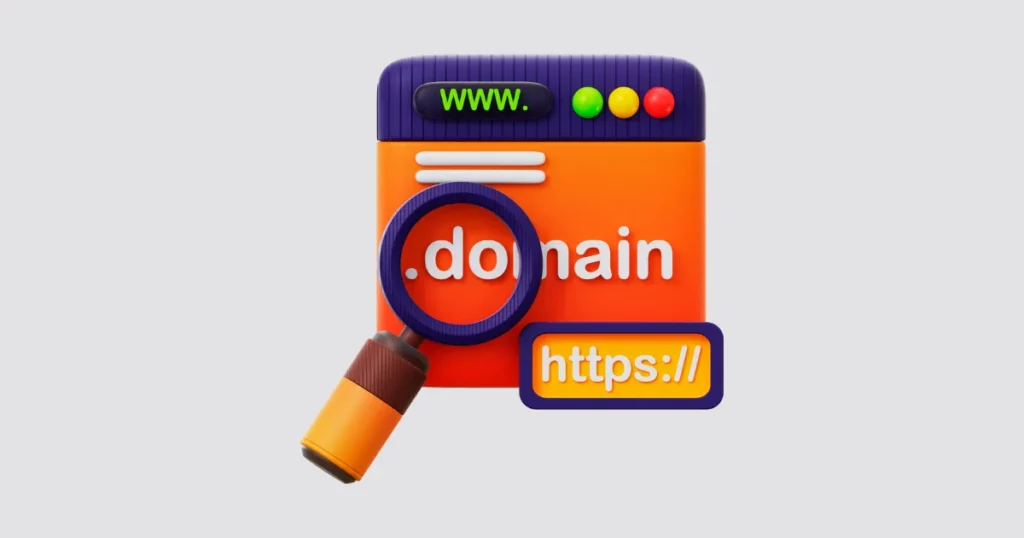
Your domain name should match your brand and business goals. It should be easy to remember and access. Short names are better than long ones. Avoid confusing names with repeating letters.
When choosing your domain name, keep these tips in mind:
- Avoid Hard-to-Spell Names: Use simple words or known phrases so customers can easily find your site.
- Choose a Scalable Name: Pick a name that can grow with your business. Your business might change over time, so make sure the name can adapt.
- Be Unique: Make sure your domain name stands out and isn’t easily confused with other businesses.
6. Customize Your Store and Select Templates
Customizing your online store is a crucial step in establishing your brand identity and providing a seamless shopping experience for your customers. Here’s how you can effectively customize your store and choose the right templates:
→Selecting Templates
Templates, also known as themes, define the look and feel of your online store. Here are key considerations for selecting the perfect template:
- Responsive Design: Ensure the template is mobile-friendly. With a significant portion of traffic coming from mobile devices, a responsive design enhances user experience. Check how the template looks on different devices to ensure consistency.
- Ease of Customization: Choose a template that is easy to customize without requiring advanced technical skills. Look for drag-and-drop features and intuitive design interfaces.
- Industry Suitability: Select a template that aligns with your niche. For a clothing store, look for templates specifically designed for fashion retailers. Templates should have features like product galleries, zoom functionality, and review sections.
- Loading Speed: Select a template that loads quickly and is lightweight. Both SEO rankings and user experience are enhanced by quick loading times.
- Built-in Features: Ensure the template includes essential features such as a shopping cart, wishlist, and product filters. Look for templates with integrated SEO features to help improve search engine visibility.
→Customizing Your Template
Once you’ve selected a template, it’s time to customize it to reflect your brand:
- Logo and Colors: Upload your logo and set your brand colors. Consistent branding helps build recognition and trust.
- Typography: Choose fonts that align with your brand’s personality. Ensure readability and consistency across all pages.
- Hero Image or Slider: Feature high-quality images of your best products or promotions. This is the first thing visitors see, so make it captivating.
- Navigation Bar: Design a clean and easy-to-navigate menu. Categories should be clear and logically organized.
- High-Quality Images: Use multiple high-resolution images for each product. Include zoom and 360-degree view options if possible.
- Detailed Descriptions: Write clear, detailed product descriptions with relevant keywords. Include size guides, materials, and care instructions.
- About Us: Tell the mission and story of your brand on a personal level.
- Blog: Maintain a blog to provide valuable content, such as styling tips, product care guides, and industry news. This can also improve your SEO. Include a section with client endorsements and reviews. Positive reviews promote purchases and foster trust.
- Call-to-Actions (CTAs): Use clear and compelling CTAs like “Shop Now,” “Explore Collection,” or “Sign Up for Updates” to guide users towards desired actions.
7. Launch your online clothing Store
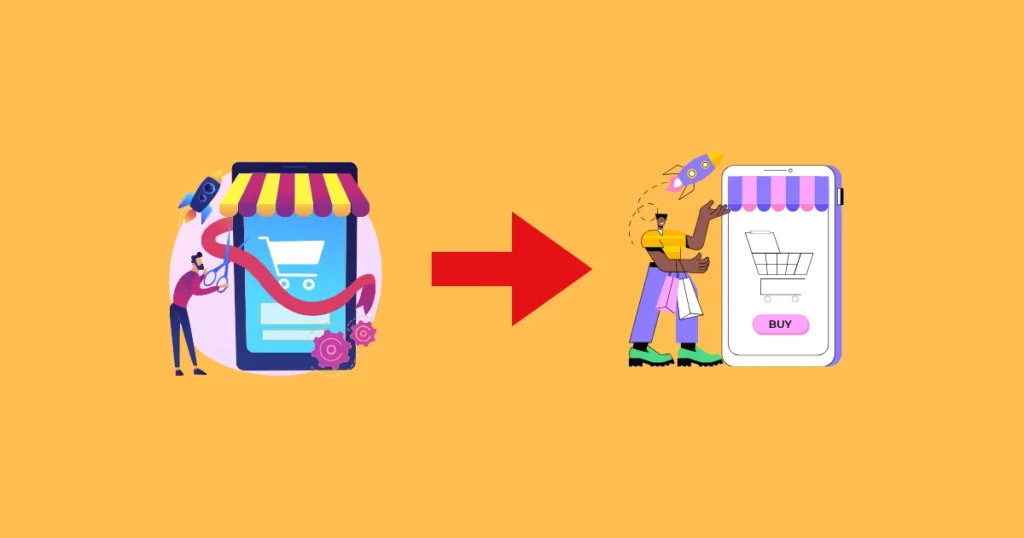
After creating a business account on an eCommerce website, it’s time to launch your clothing brand to the public. Without letting customers know about it, they won’t visit.
→Plan Your Launch
It’s important to let customers know about your new online store. Offer attractive deals and discounts to grab their attention. Consider giving gifts with their first purchase to make it special.
→Use Social Media
Connect your online store with your social media accounts. This makes it easy to share updates and promotions with your followers.
→Build Excitement
Social media is a great way to spread the word. Connect with friends and family to expand your reach. Everyone can help spread the news about your new online clothing store and its offers.
8. Start Promoting and Selling Your Products
Once your online store is set up, it’s time to drive traffic and convert visitors into customers.
Now that your store is created, the supply chain is set, and you are ready to ship your products. You need to start promoting and bringing orders for your clothing brand.
Almost all D2C brands rely on social media ads, google ads, affiliate marketing, influencer marketing, and social media content to reach and acquire new customers.
Here are effective strategies for promoting and selling your products:
→Organic Marketing
Utilize organic marketing tactics to reach your audience without paid advertising:
- Search Engine Optimization (SEO): Optimize your website for search engines to improve visibility in organic search results. Focus on keyword research, meta tags, content quality, and backlink building.
- Content Creation: Produce high-quality, relevant content such as blog posts, tutorials, and product guides. This not only engages your audience but also boosts SEO and establishes your authority in the industry.
→Social Media Marketing
Engage with your audience and drive sales through social media marketing:
- Platform Selection: Select social media channels that best represent the activity of your target market. Common platforms include Instagram, Facebook, Pinterest, and TikTok.
- Content Strategy: Create visually appealing content showcasing your products. Make use of a variety of user-generated content, lifestyle shots, films, and product photos.
- Engagement: To keep your audience interested, reply to messages, mentions, and comments. Encourage user-generated content through contests, hashtags, and challenges.
→Email Marketing
Use email marketing to nurture leads and promote recurring business:
- Building Your List: Offer incentives such as discounts or freebies in exchange for email sign-ups. Place opt-in forms strategically on your website and during checkout.
- Email list segmentation: Divide your list into groups according to engagement level, purchase history, and demographics. Send targeted, personalized emails to improve open rates and conversions.
- Automation: Set up automated email sequences for welcome emails, abandoned cart reminders, post-purchase follow-ups, and product recommendations.
→Paid Advertising
Drive immediate traffic and sales with paid advertising campaigns:
- Google Ads: Run pay-per-click (PPC) ads on Google to target users actively searching for products like yours. Use keywords, ad extensions, and compelling ad copy to maximize click-through rates.
- Social Media Ads: Launch targeted ads on social media platforms to reach specific demographics, interests, and behaviors. Try out various ad placements, formats, and audience targeting choices.
→Content Marketing
Educate, entertain, and engage your audience through content marketing:
- Blogging: Maintain a blog on your website to publish informative and engaging content related to your industry, products, and customer interests.
- Video Content: Create video content such as product demonstrations, tutorials, behind-the-scenes footage, and customer testimonials. Host videos on your website and share them on social media platforms and YouTube.
→PPC Marketing
Maximize your visibility and drive traffic with pay-per-click (PPC) marketing:
- Keyword Research: Conduct thorough keyword research to identify relevant search terms with high commercial intent. Target these keywords in your PPC campaigns to attract qualified leads.
- Ad Copy Optimization: Write compelling ad copy that highlights your unique selling points, benefits, and offers. Use ad extensions like sitelinks, callouts, and reviews to enhance ad visibility and relevance.
9. Partner with shipping and logistics company
There are many delivery services (courier) aggregators in India. Here are all the major aggregators you can partner with for shipping products pan India: Shiprocket, NimbusPost, Shyplite, Vamaship, EShopBox, Click Post, and Pickrr. You can also directly partner signup on Bluedart or Delhivery for generating pickup and delivery orders.
Almost all the delivery providers have competitive pricing and similar kind of success rates for delivery. So there’s not much you can do here. We recommend getting started with the one that fits your budget and delivers to the cities that you think your customers would be from.
Best Tactics for a Successful Online Clothing Store Business
Launching an online clothing store? Here are key tactics to ensure success:
1. Seamless Website Navigation
Ensure your website is easy to navigate, allowing customers to find products effortlessly. Clear categories and intuitive menus enhance the shopping experience.
2. SEO Optimization
Optimize your website for search engines to improve visibility. Use relevant keywords, meta tags, and high-quality content to rank higher in search results and attract more organic traffic.
3. Attractive Website Design
Create a visually appealing and user-friendly website design. Invest in high-quality images, intuitive layout, and mobile responsiveness to captivate visitors and encourage browsing.
4. Convenient Payment Methods
Offer a variety of popular payment methods to accommodate customer preferences. Include options like credit/debit cards, PayPal, and digital wallets for seamless transactions.
5. Targeted Promotion
Promote your store on platforms frequented by your target audience. Utilize social media, influencer partnerships, and targeted ads to reach potential customers where they spend their time online.
How To Start an Online Clothing Store With No Money
Using Blinkstore, you can start an online clothing store with no money. Here’s an infographic to quickly show you how Blinkstore works:
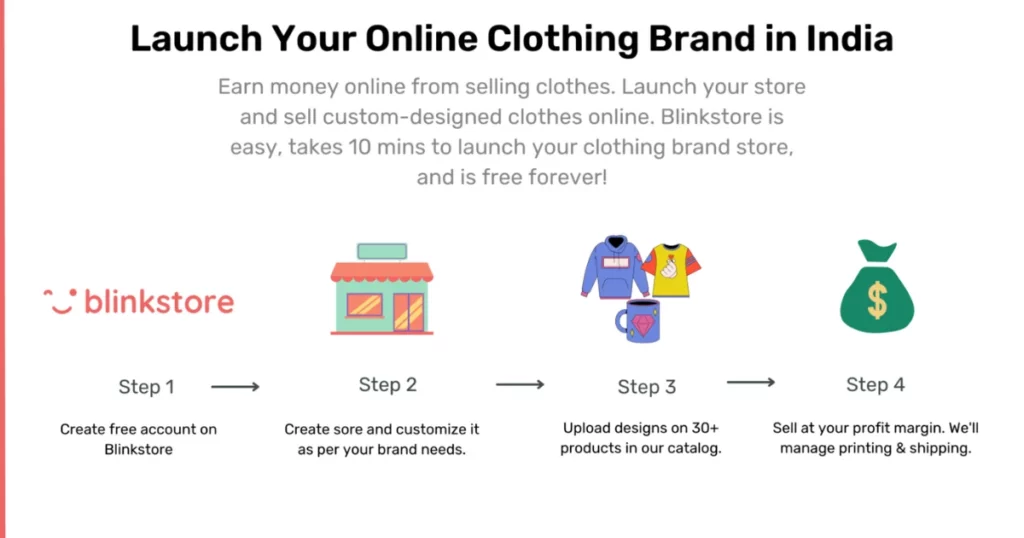
If you chose Blinkstore to launch your online clothing store in India, you can simply skip all the laborious and complex steps. With Blinkstore, you can launch your store for free which has in-built integration with print-on-demand, shipping, and payment gateway.
Here’s how you can launch your clothing brand using Blinkstore:
- Signup on Blinkstore and create your store
- Choose products from our catalogue of 30+ products that you want to sell and upload your designs on them to customise.
- Put your own profit margin on top of the base price of the products.
- List them on your store and customise your store as per the brand’s needs.
- You are ready to sell!
Blinkstore takes care of the inventory, printing on demand, shipping, and payments. All you need to do is create great products and do marketing. Blinkstore is free forever and you can launch your clothing brand in India with no money.
How to promote your online clothing store in India
Here are 5 quick ways to promote your online clothing store in India:
- Create content around your products on social media.
- Promote your online clothing store using Facebook and Instagram Ads
- Promote your products using Google Ads: Display Ads, Search Ads, YouTube ads, and more.
- Collaborate with social media influencers to do influencer marketing.
- SEO: By starting a blog to share style tips, write content for fashion and apparel consumers, and promote your products within them.
Other than these 5 methods, here are 6 ways to increase the distribution of your clothing brand and store in India:
1. Sell on Amazon
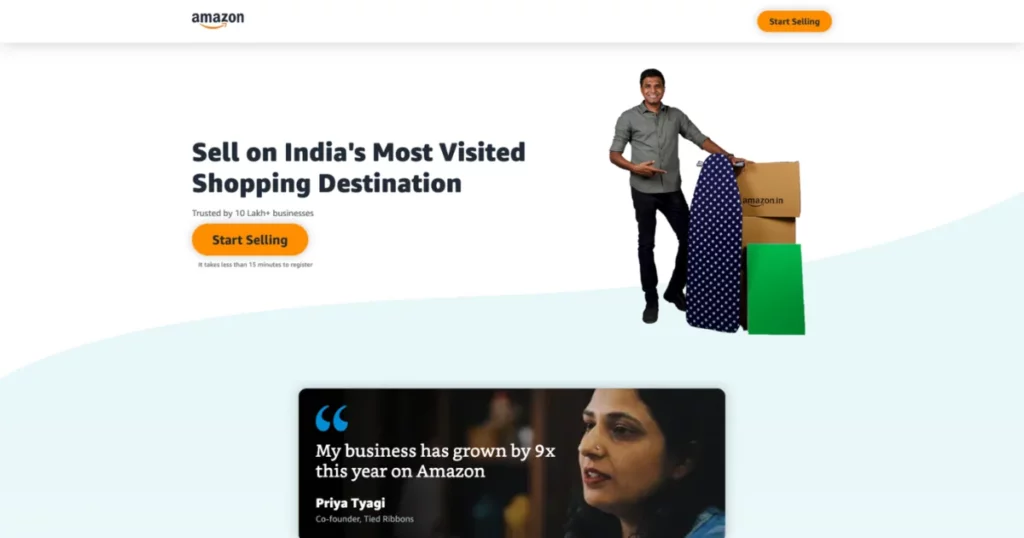
You can signup on to Amazon to become an Amazon Seller. Do note that you’d need to pay for the warehouse and promote your products on the Amazon marketplace. Amazon is a preferred marketplace for all D2C brands in India. It does cost money to bring sales on Amazon but this is a reliable marketplace to get your GMV growing.
2. Sell on Meesho
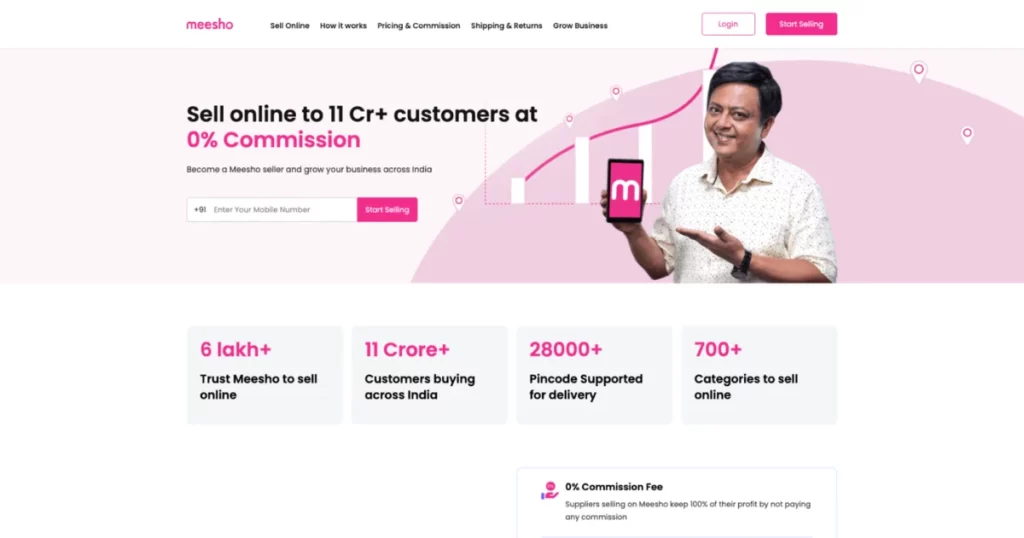
Meesho is a great marketplace if your audience is in tier-2 cities of India. Signing up on meesho is simple and you can become a seller quickly at 0 costs on Meesho and start selling across India.
3. Sell on Flipkart
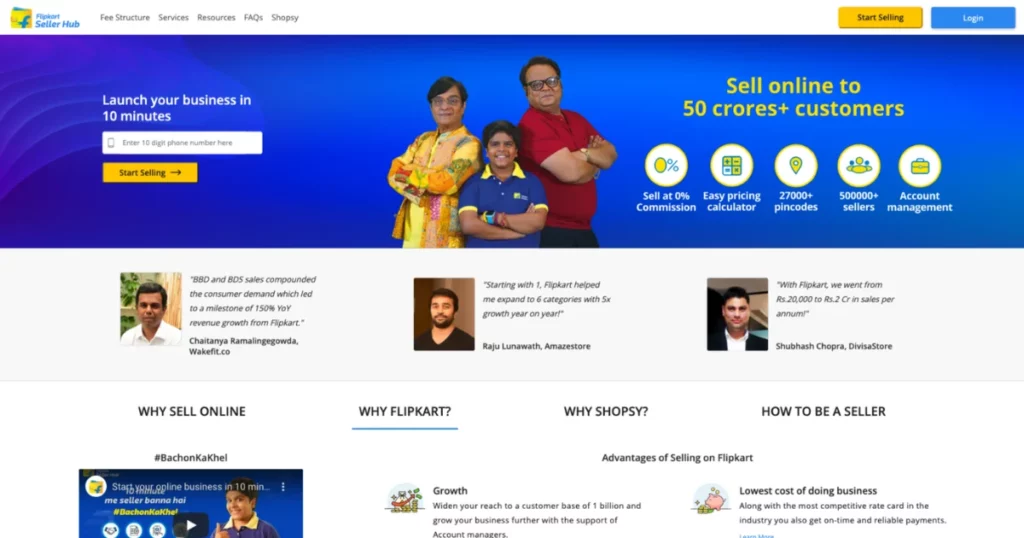
Amazon’s biggest rival, Flipkart is a great marketplace to register as a seller and promote your clothing brand.
4. Sell on Swiggy Mini Store
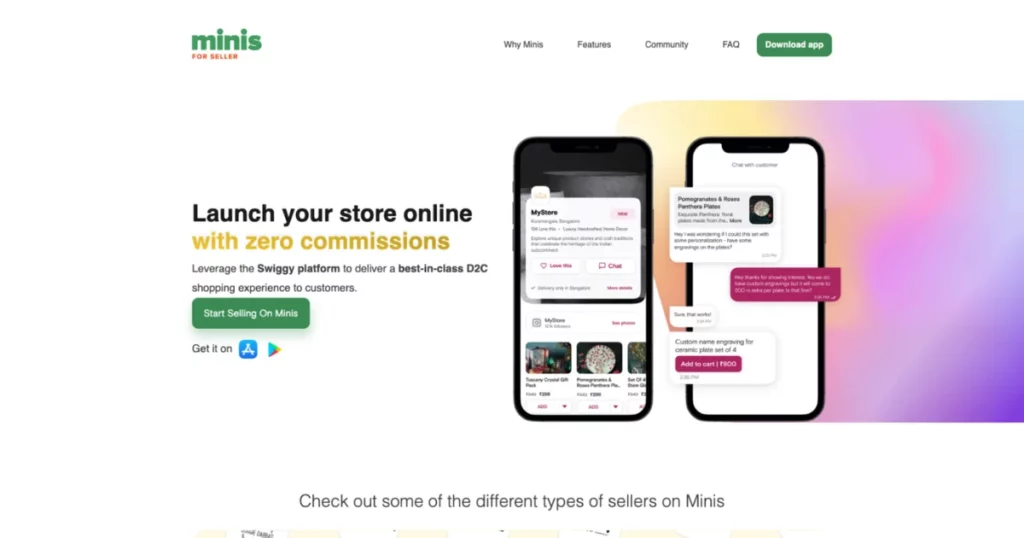
Swiggy recently launched Mini Store, a platform for D2C brands to create their own store and start selling across India. Your shop can also get featured on the swiggy app within the “Minis” tab and this can become a great place for creating awareness around your brand.
5. Sell on Myntra
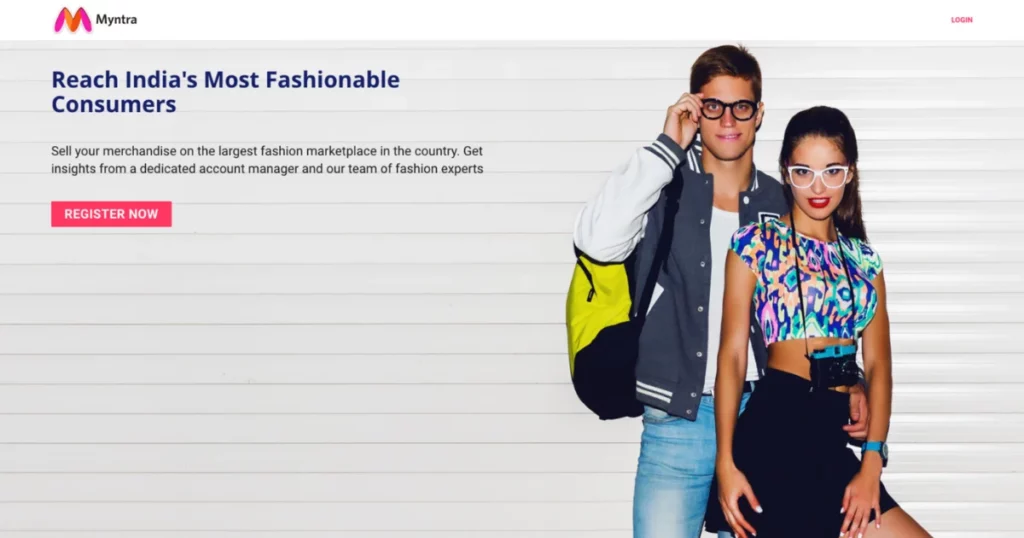
Myntra (+Jabong) has very strict standards for any clothing brand to signup on them. Once you pass their strict requirements, you can start selling on India’s biggest fashion marketplace.
6. Sell on Social Media

Social media content creators are most suited for selling clothes and accessories online through their personal social media presence and engaging content. With Blinkstore, social media creators can easily launch their clothing brands and start selling online.
Social Media is a key distribution and awareness channel for all D2C clothing brands. So selling and promoting on social media will remain a big part of your marketing strategy.
If you are a creator, you can read How to earn money from social media in India and explore more ways to earn money online. Other than learning how to start an online clothing store, you can also learn How To Earn Money From Instagram in India and How To Earn Money From Youtube in India.
Examples of successful online clothing stores in India
Here are a few examples of good online clothing stores and brands in India. Now that you have a basic idea of How to start an online clothing brand in India, let’s look at some clothing brands built on Blinkstore, Shopify, and custom-built.
1. TeeCuppers
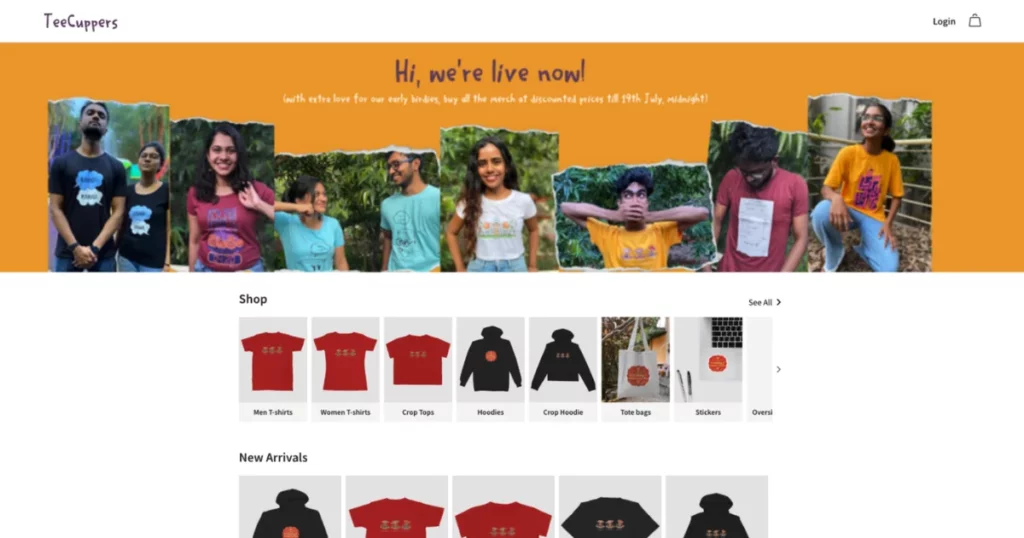
Teecuppers is a brand run by college students. This store is built using Blinkstore and they have very interesting product designs to offer.
2. blrtees
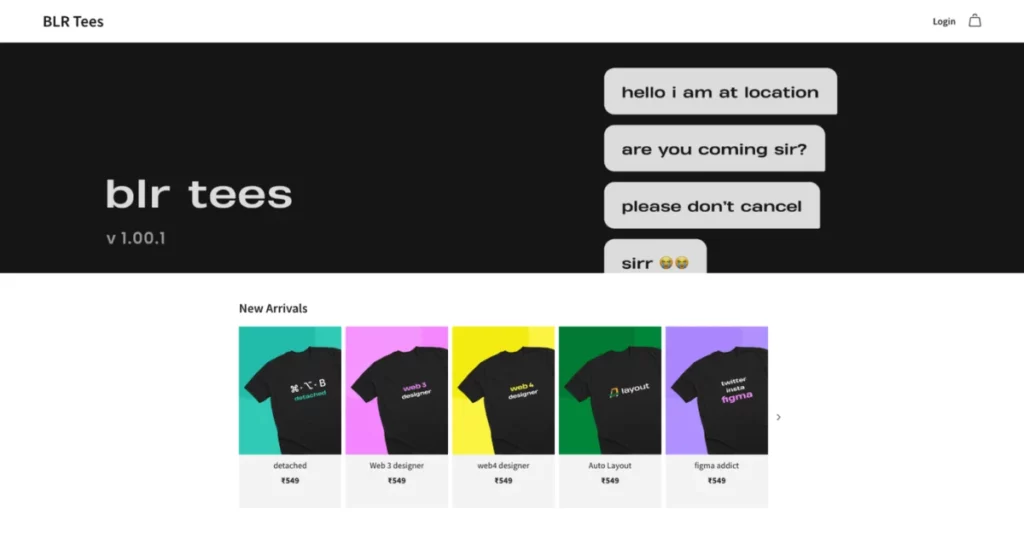
BlrTees is a store run by a designer from Bangalore. The idea behind this store is to create funky products and catchy t-shirts for startup founders, designers, and people who are in Bangalore’s tech scene.
3. Pet Music Videos
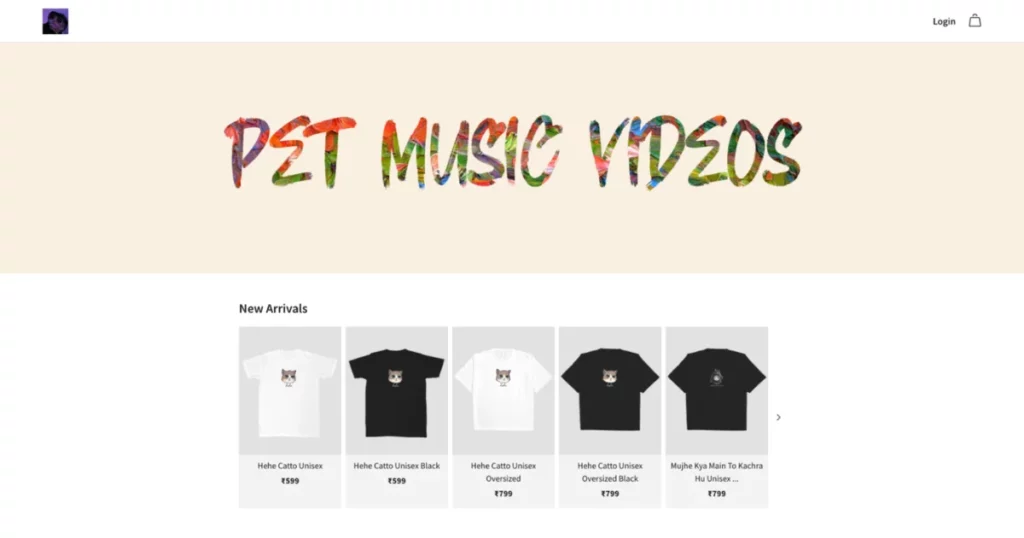
Pet Music Videos is an Instagram page running its own merchandise store built on top of Blinkstore. If you are a fan of cat memes and you like cats, you’d find their products very interesting.
4. Sleek&Peek
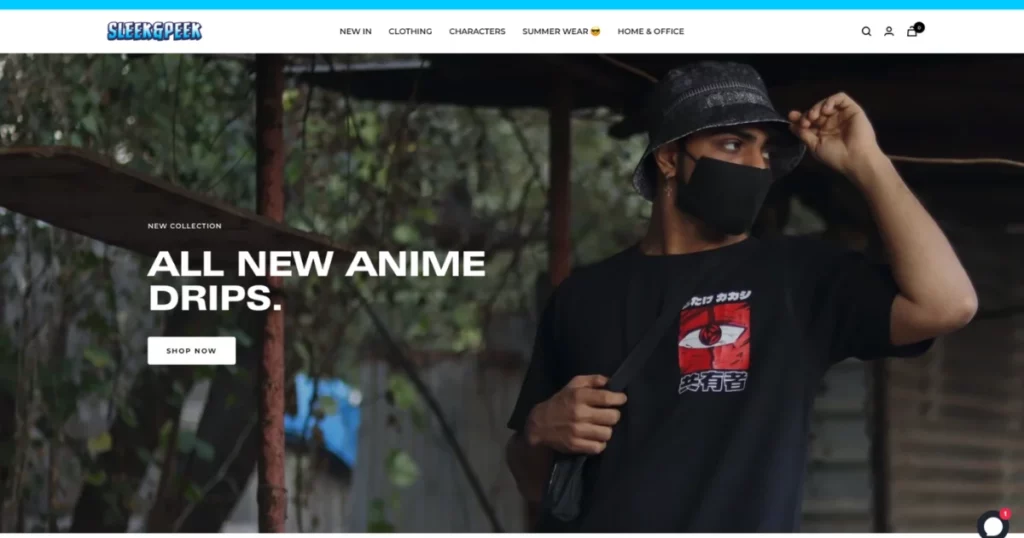
Sleek&Peek is a store built on Shopify and they work with a number of print-on-demand partners to fulfil their orders. They use Google Ads and social media ads for promoting the products. This is an example of Shopify + PoD + Payments + Shipping patchwork. You’d find anime products in this store.
5. MelangeBox
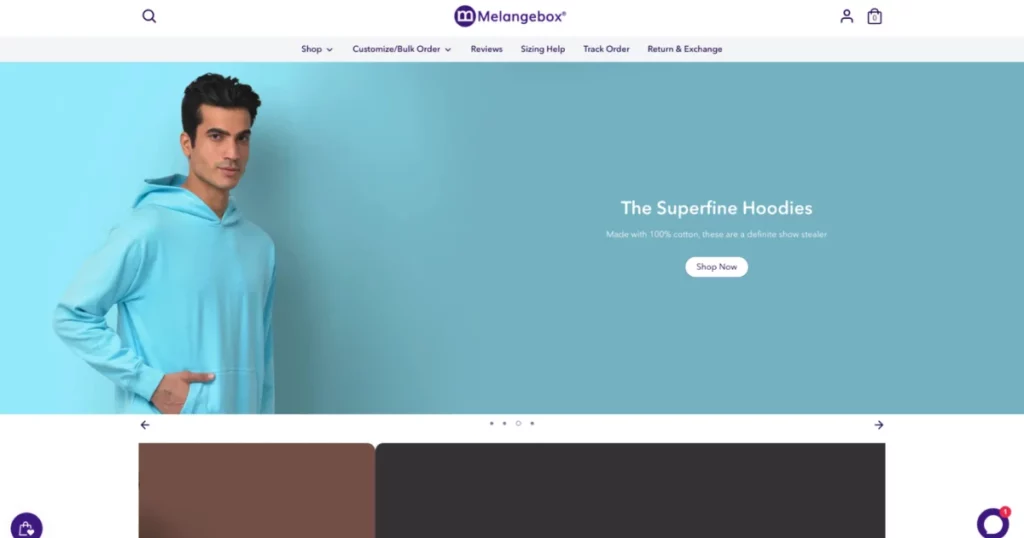
MelangeBox is a well-known D2C apparel brand in India. They sell solid-coloured apparel online. This store is an example of a custom-built website that procures apparel from 3rd party manufacturers and also manufactures new products in-house. They need to maintain their own inventory and rely on shipping partners to deliver.
6. BLUORNG
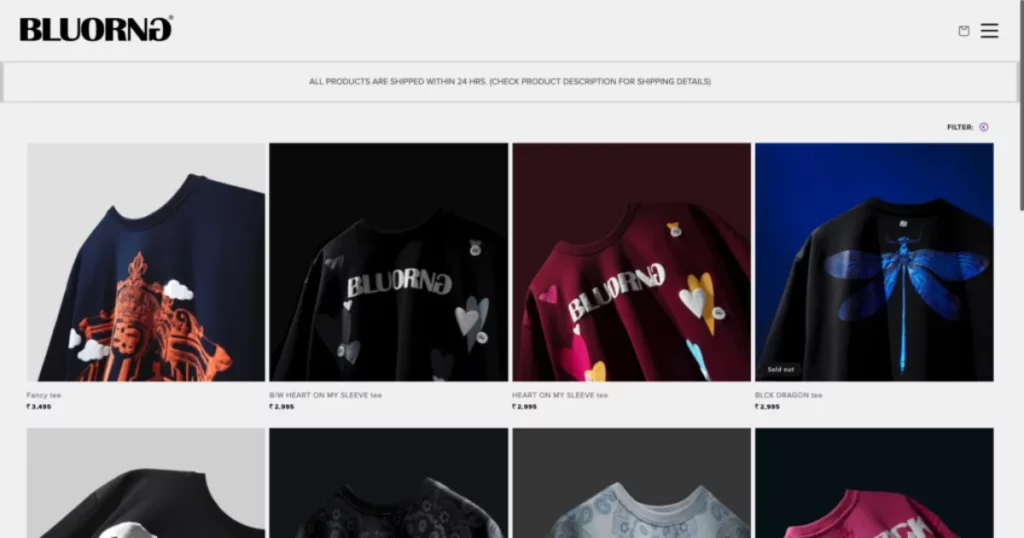
Bluorng is a street-wear apparel brand. This is an example of a store built on Shopify. And this brand designs and get’s the product manufactured as per their own requirements.
Conclusion
Online fashion market size in direct to consumer (D2C) sector in India from 2015 to 2020, with estimates until 2025. The direct-to-consumer sector in India will become a $43.2 Billion worth of industry. And there will be thousands of brands commanding a pie of that market.
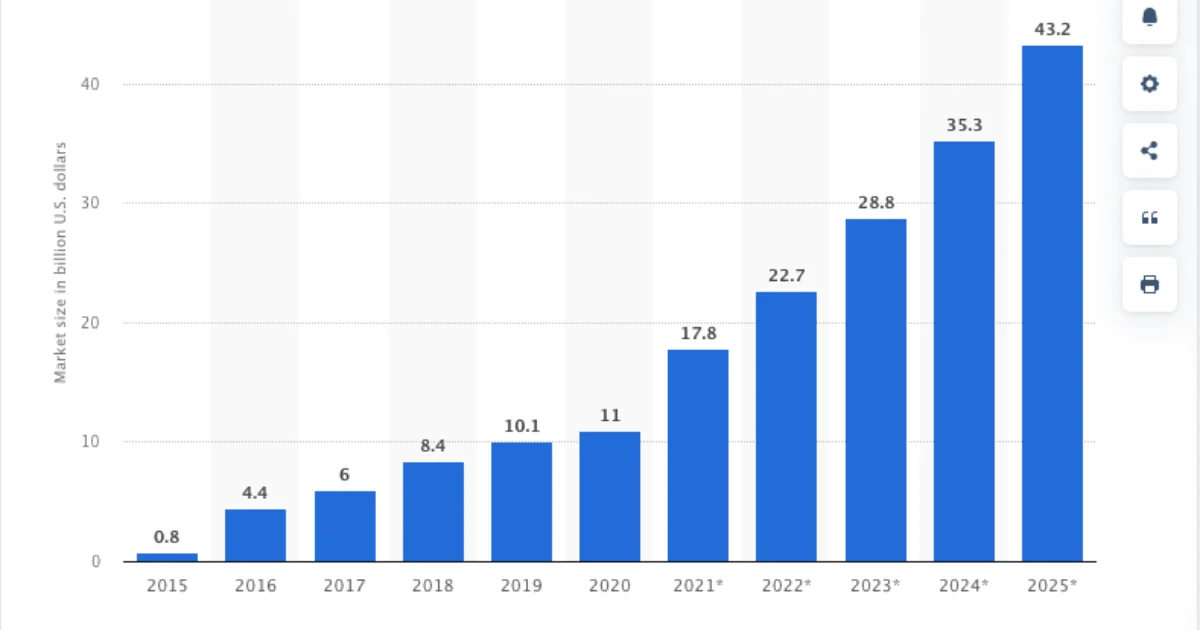
We would recommend that you start an online clothing store in India and start executing. Over time you’ll learn, optimise your methods to generate sales, and make it into a profitable business that pays you good money.
It is a great skill to learn Design and sell t-shirts online in India, there is a possibility of millions of new D2C brands catering to a niche but the loyal audience in the market.
FAQs – How to start an online clothing store
Let’s answer some of the frequently asked questions at the top of “How to start an online clothing store”.
How do you create an online clothing store?
Create your online clothing store using Blinkstore, Shopify, Woocommerce, Bigcommerce, Wix, etc. These are e-commerce store builders that are mostly preferred for creating an online clothing store.
How much does it cost to start your own online clothing store?
Staring your own online clothing store can cost anywhere between Rs. 0 to Rs. 10 Lakh. It all depends on what platform your choose and what kind of model you want to get go ahead with. For example, if you start a print-on-demand online clothing store using Blinkstore, it’ll cost you Rs. 0. If you choose to start with Shopify + a print-on-demand partner, it will cost at least $29/month for Shopify. To start your in-house manufacturing or warehouses, you’d need to spend up to Rs. 10 Lakh or more.
Do online clothing stores make money?
Yes, online clothing stores make anywhere from Rs. 10,000 a month to Rs. 15,00,000 a month depending on the sale and marketing. Bewakoof clothing store makes Rs. 200 Crore in revenue a year. Starting an online clothing brand can be a very profitable business. Statista estimates that the apparel and accessories online market will generate over $153 billion in revenue by 2024.
How much does the average online clothing store make?
On average small and medium-scale online clothing stores make Rs. 5000 to Rs. 20,00,000 per month depending on how much they sell and promote their store. If the average order value for your clothing store is Rs. 500, it’ll take you 10 orders to do Rs. 5000 in monthly revenue. And to reach Rs. 20 Lakh in a month, you’d need to get 4000 orders a month. Which roughly translates to 133 orders per day.
How much stock will I need to start an online clothing store?
With Blinkstore, you need no stock (zero inventory) to start an online clothing store. That’s your answer for “how to start an online clothing store without inventory”. Otherwise, you’d need to predict the demand for each of your products and stock the inventory in your warehouse.
How Long Does It Take to Create an Online Clothing Store?
With Blinkstore, it takes less than 10 minutes to create an online clothing store and start selling. If you go with Shopify or another e-commerce store builder, creating a store will not take more than one hour. But then you’d need to spend 3-4 weeks in figuring out and establishing the supply chain of the products.
Is it profitable to start an online clothing store?
Yes, it is profitable to start an online clothing store in India. Many Print-on-demand stores in India earn anywhere from Rs. 5000 per month to Rs. 20 Lakh a month. The profitability of your online clothing store depends on how you optimise the cost of operations, cost of marketing, taxes, and ensure 10% to 20% of profit margins.
Is it hard to start a clothing business?
Doing any business is never an easy task. But today, the complexity of starting any business has greatly reduced. While it is easy to start a clothing business in India with platforms like Blinkstore, Shopify, Amazon, Print-on-demand companies, and contract manufacturers. Getting consistent sales and growing to make it a business that generates up to Rs. 10 Lakh in a month takes time. But with good ideas and careful yet fast execution, you can easily build a clothing business in India that brings you up to Rs. 50,000 in revenue every month.
